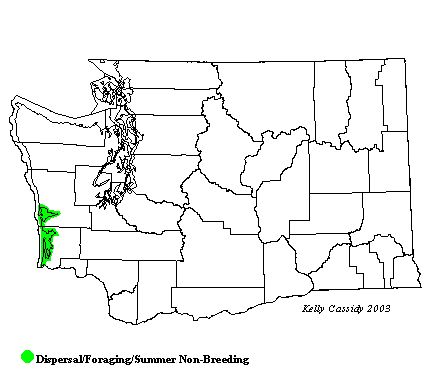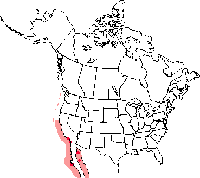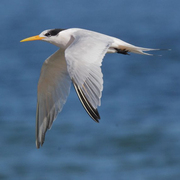Elegant Tern
The Washington representatives of this family can be split into two groups, or subfamilies. The adaptable gulls are the most familiar. Sociable in all seasons, they are mainly coastal, but a number of species also nest inland. Many—but not all—are found around people. Gulls have highly variable foraging techniques and diets. Terns forage in flight, swooping to catch fish or insects. They dive headfirst into the water for fish. Although they are likely to be near water, they spend less time swimming than gulls.
General Description
The Elegant Tern is a fairly large, slim tern, with a long, orange, slightly drooping bill. It has narrow, angled wings, a deeply forked tail, and a shaggy crest. The adult in breeding plumage has a gray mantle, white breast and belly, and white face with a black, crested cap. The legs are black. The adult in non-breeding plumage is similar, but with a white forehead that darkens to streaky black, as if the cap has receded. Juveniles appear similar to non-breeding adults, but their legs are yellow.
Habitat
A coastal species, the Elegant Tern is found in shallow waters, in bays and estuaries, and sometimes far out to sea. It is extremely rare inland. Nesting habitat is isolated, flat, sandy or rocky islands without much vegetation, and is restricted to five sites in Mexico and southern California.
Behavior
Elegant Terns are highly social and very vocal, especially when feeding in flocks. They forage by flying over water, hovering, and plunging down to catch prey below the water's surface.
Diet
The key prey of this species on its breeding grounds is the northern anchovy. Other small fish and small crustaceans round out the diet.
Nesting
Elegant Terns sometimes breed in mixed colonies with other terns or Heerman's Gulls, where their nests are packed closely together. They nest on bare ground, out in the open. Both parents help to make a simple scrape in the ground, collecting debris to form a rim and sometimes lining the scrape with pebbles or shells. The female lays one or perhaps two eggs. Incubation is by both sexes, and lasts about 4 weeks. After hatching, the chick stays in the nest for about a week. Then, like other crested terns, it joins a group of up to several hundred chicks called a crèche. The adults take turns guarding the crèche, standing at the perimeter of the group and herding the chicks together. A parent feeds only its own chick in the crèche, recognizing the chick by its call note. Chicks stay in the crèche until they fledge at about 35 days, after which they follow their parents for at least five or six more months.
Migration Status
Elegant Terns migrate north and south along the coast in late summer and early fall after the breeding season. Birds that dispersed northward head south again in October. Their winter range extends as far south as Peru and Chile.
Conservation Status
The Elegant Tern has the most restricted breeding distribution of any tern in North America, and only five colonies are currently known. The largest of the five, located on Isla Rasa, Mexico hosts 90-97% of the worldwide population. Historically, this is a species of limited distribution, with only about a dozen nesting colonies, but disturbance from humans and feral animals, habitat degradation, and changing climatic conditions have reduced it even further, to the current small number of colonies. The breeding range is currently expanding northward into California, however, perhaps in response to the shifting distribution of northern anchovies. The Elegant Tern is a highly vulnerable species and is listed as a species of special concern in California. Some conservationists believe that the US and Mexico should immediately list the Elegant Tern as endangered and begin recovery programs before it is too late.
When and Where to Find in Washington
The Elegant Tern is a rare visitor to Washington from July to mid-September, along the southern outer coast in sandy habitats and offshore. In some years, Elegant Terns can be found in fairly good numbers in southwestern Washington locations, e.g. Ocean Shores (Grays Harbor County) and in Pacific County. They may be absent in other years.
 Abundance
Abundance
| Ecoregion | Jan | Feb | Mar | Apr | May | Jun | Jul | Aug | Sep | Oct | Nov | Dec |
|---|---|---|---|---|---|---|---|---|---|---|---|---|
| Oceanic | ||||||||||||
| Pacific Northwest Coast | I | I | ||||||||||
| Puget Trough | ||||||||||||
| North Cascades | ||||||||||||
| West Cascades | ||||||||||||
| East Cascades | ||||||||||||
| Okanogan | ||||||||||||
| Canadian Rockies | ||||||||||||
| Blue Mountains | ||||||||||||
| Columbia Plateau |
Washington Range Map

North American Range Map


Family Members
 Laughing GullLarus atricilla
Laughing GullLarus atricilla Franklin's GullLarus pipixcan
Franklin's GullLarus pipixcan Little GullLarus minutus
Little GullLarus minutus Black-headed GullLarus ridibundus
Black-headed GullLarus ridibundus Bonaparte's GullLarus philadelphia
Bonaparte's GullLarus philadelphia Heermann's GullLarus heermanni
Heermann's GullLarus heermanni Black-tailed GullLarus crassirostris
Black-tailed GullLarus crassirostris Short-billed GullLarus canus
Short-billed GullLarus canus Ring-billed GullLarus delawarensis
Ring-billed GullLarus delawarensis California GullLarus californicus
California GullLarus californicus Herring GullLarus argentatus
Herring GullLarus argentatus Thayer's GullLarus thayeri
Thayer's GullLarus thayeri Iceland GullLarus glaucoides
Iceland GullLarus glaucoides Lesser Black-backed GullLarus fuscus
Lesser Black-backed GullLarus fuscus Slaty-backed GullLarus schistisagus
Slaty-backed GullLarus schistisagus Western GullLarus occidentalis
Western GullLarus occidentalis Glaucous-winged GullLarus glaucescens
Glaucous-winged GullLarus glaucescens Glaucous GullLarus hyperboreus
Glaucous GullLarus hyperboreus Great Black-backed GullLarus marinus
Great Black-backed GullLarus marinus Sabine's GullXema sabini
Sabine's GullXema sabini Black-legged KittiwakeRissa tridactyla
Black-legged KittiwakeRissa tridactyla Red-legged KittiwakeRissa brevirostris
Red-legged KittiwakeRissa brevirostris Ross's GullRhodostethia rosea
Ross's GullRhodostethia rosea Ivory GullPagophila eburnea
Ivory GullPagophila eburnea Least TernSternula antillarum
Least TernSternula antillarum Caspian TernHydroprogne caspia
Caspian TernHydroprogne caspia Black TernChlidonias niger
Black TernChlidonias niger Common TernSterna hirundo
Common TernSterna hirundo Arctic TernSterna paradisaea
Arctic TernSterna paradisaea Forster's TernSterna forsteri
Forster's TernSterna forsteri Elegant TernThalasseus elegans
Elegant TernThalasseus elegans

